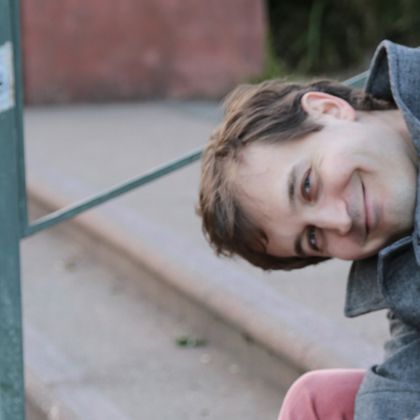(photo credit)
Concert Review: SFCMP's His Own Space of Freedom—Theatrically Engaging and Musically Diverse
Rating: 4.5 out of 5 stars
The San Francisco Contemporary Music Players presented their final concert of the 2009/2010 season tonight, 26 Apr 2010, at the Herbst Theater in downtown San Francisco. On the program were pieces by Greek composer Manolis Manousakis, American Tan Dun, Chinese Guo Wenjing, and Frenchman Philippe Hurel. This program was presented coherently and engagingly, because proper attention was paid not only to selecting and preparing the music, but also to lighting, staging, and technological aspects—a rare achievement.
A major criticism I have of many new music concerts is the programming. When an audience is presented with complex music, much of it often music they have never heard, it is crucially important to help the audience find a path into the music. In my opinion, concerts should be transcendent experiences (as opposed to listening exams), in which the audience hears something in a new and satisfying way. Toward this end, how a piece is presented in concert is often more important than what piece is presented.
The first piece on the program was Manousakis’s A Time to Break Silence, Speaking Truth to Power. This solo bassoon piece was commissioned by Rufus Olivier, who played it tonight. Musically, A Time to Break Silence is a success. It is challenging and full of craft, but not at the expense of musicality. What stands out is Manousakis’s beautiful phrasing and a lyricism that is unexpected in a piece consisting largely of multiphonics and quartertones.
The one area in which the piece falls short, however, is its extramusical theme. Olivier had asked for a piece about the American civil rights movement—a theme that Greek composer Manousakis was clearly uncomfortable with. The performance was preceded by a video collage about the civil rights, after which Olivier entered and began performing. Unfortunately, the contrast of a giant, frenetic video projection to a subtle, solo bassoon piece was jarring. Manousakis may have tried to write a civil rights piece, but he didn’t—this is simply a beautiful solo bassoon piece and should be presented that way, without the awkward video.
Next was one of Tan Dun’s more well-known pieces, Water Music, and from this point onward, the concert was completely engaging. The four percussionists entered from the back of the hall, which had been darkened more than usual, playing as they walked. After reaching the stage, they set to work on their “water drums”: giant glass bowls full of water on pedestals. The hall stayed unusually dark, but the bowls were illuminated with blue light, which placed the focus on the hands of the percussionists as they played with the water.
Additionally, the piece was messy, with water flying everywhere; at one point a percussionist carefully turned a soggy page of music, to comic effect. Tan Dun wrote Water Music so that natural water sounds would weave in and out of more musical structures. Sometimes it seemed like we were listening to water as we hear it every day; at other times, the sounds were distinctively those of a percussion ensemble and it was easy to forget that the instrument was in fact water.
A fantastic performance aside, what made the piece a success was the lighting and staging. Focusing our attention on the water bowls helped to draw the audience into Tan Dun’s musical concept. Furthermore, the darkened hall and focused beams of light allowed us to see not only the hands in the bowls, but the water splashing out. At times, the percussionists were so in tune with each other that water would fly out of all four bowls at once and land in unison on the stage, which was thrilling to watch.
Next on the program was Guo Wenjing’s Parade, written for six Chinese opera gongs and three percussionists. Guo Wenjing uses complex choreography and a mixture of sticks and mallets to build a varied and interesting percussion piece. However, as interesting as it is to hear, it is even more interesting to see close up, due to the intertwining of the percussionists’ mallets. In another intelligent programming decision, SFCMP mounted a camera over the table holding the gongs and projected a live feed of the percussionists’ hands. This close-up perspective felt like an augmentation of the focused lighting of the previous piece.
The last piece on the program was Hurel’s Figure libres, conducted by Christian Baldini. In this piece, Hurel shows clear harmonic influences from Grisey and orchestrational and formal ideas taken perhaps from Rihm. In any case, the result was a connoisseur’s piece. A certain knowledge of the spectral repertoire and a love of microtonal harmonies is required to fully appreciate Figure libres’s colourful counterpoint.
However, Figure libres would not have worked with a light show or theatrics. The theatricality of Figure libres is in the virtuosic trading of themes between players. Figure libres is a challenging tour de force for the conductor and ensemble, and Baldini was able to bring out the nuances in Hurel’s score and coordinate the syncopated counterpoint between the players. Anything more than the music would have been distracting in such an intricate piece.
Taken as a whole, His Own Space of Freedom worked well as a program. Despite the fact that all four composers on the program come from very different aesthetic places, the concert felt unified because SFCMP made an effort to present each piece in its best light—quite literally. The effect was similar to that of having four interesting people over for dinner and getting to know each of them in turn, in their element. Too often new music concerts feel more like drawn-out small talk. His Own Space of Freedom was very satisfying as an event and I hope that it ends up serving as a model for future concerts at SFCMP and elsewhere.


